
Overview
The article presents a systematic approach to Conversion Rate Optimization (CRO) testing, outlining five essential steps designed to enhance the profitability of Direct-to-Consumer (DTC) brands. Understanding CRO methodologies is paramount; thorough research lays the groundwork for success. By formulating clear hypotheses, brands can execute tests methodically, ensuring that each step is intentional and focused. Analyzing results is critical, as it fosters continuous improvement in conversion rates. Evidence supports the assertion that systematic CRO practices yield significant returns on investment, underscoring the necessity of adopting this strategic framework.
Introduction
Mastering conversion rate optimization (CRO) testing is crucial for direct-to-consumer (DTC) brands seeking to enhance profitability and customer engagement. By systematically analyzing and refining website elements, brands can unlock substantial improvements in conversion rates, transforming casual visitors into loyal customers.
However, the plethora of methodologies and tools available can make navigating the complexities of CRO testing daunting. How can brands effectively maneuver through this landscape to achieve measurable results?
Understand the Basics of CRO Testing
CRO testing represents a systematic approach designed to elevate the effectiveness of your website or landing pages in converting visitors into customers. This process encompasses various methodologies, including A/B analysis, multivariate analysis, and experience evaluation. Understanding these techniques is crucial for CRO testing, as they help identify which elements of your site resonate with users and foster engagement. Key concepts include:
- Conversion Rate: The percentage of visitors who complete a desired action, such as making a purchase.
- A/B Testing: This method involves comparing two versions of a webpage to ascertain which one performs better. A/B experimentation is particularly impactful in e-commerce, where even minor adjustments can lead to significant increases in sales rates. For instance, Dell reported an impressive 300% rise in success rates attributed to their A/B trials.
- User Experience (UX): The overall experience a user encounters when interacting with your site can greatly affect conversion rates. A well-optimized UX can result in enhanced engagement and reduced bounce rates.
Mastering these foundational concepts empowers you to implement strategies for CRO testing tailored to your brand's unique needs. Optimal approaches for A/B experiments include prioritizing evaluations based on potential impact, maintaining a repository of previous experiments for ongoing learning, and ensuring clear communication regarding expectations. As industry leaders emphasize, embracing CRO testing is vital for maintaining competitiveness in today's market. With 80% of evaluations being halted before achieving , it is imperative to commit to a structured assessment approach that fosters continuous improvement and informed decision-making.
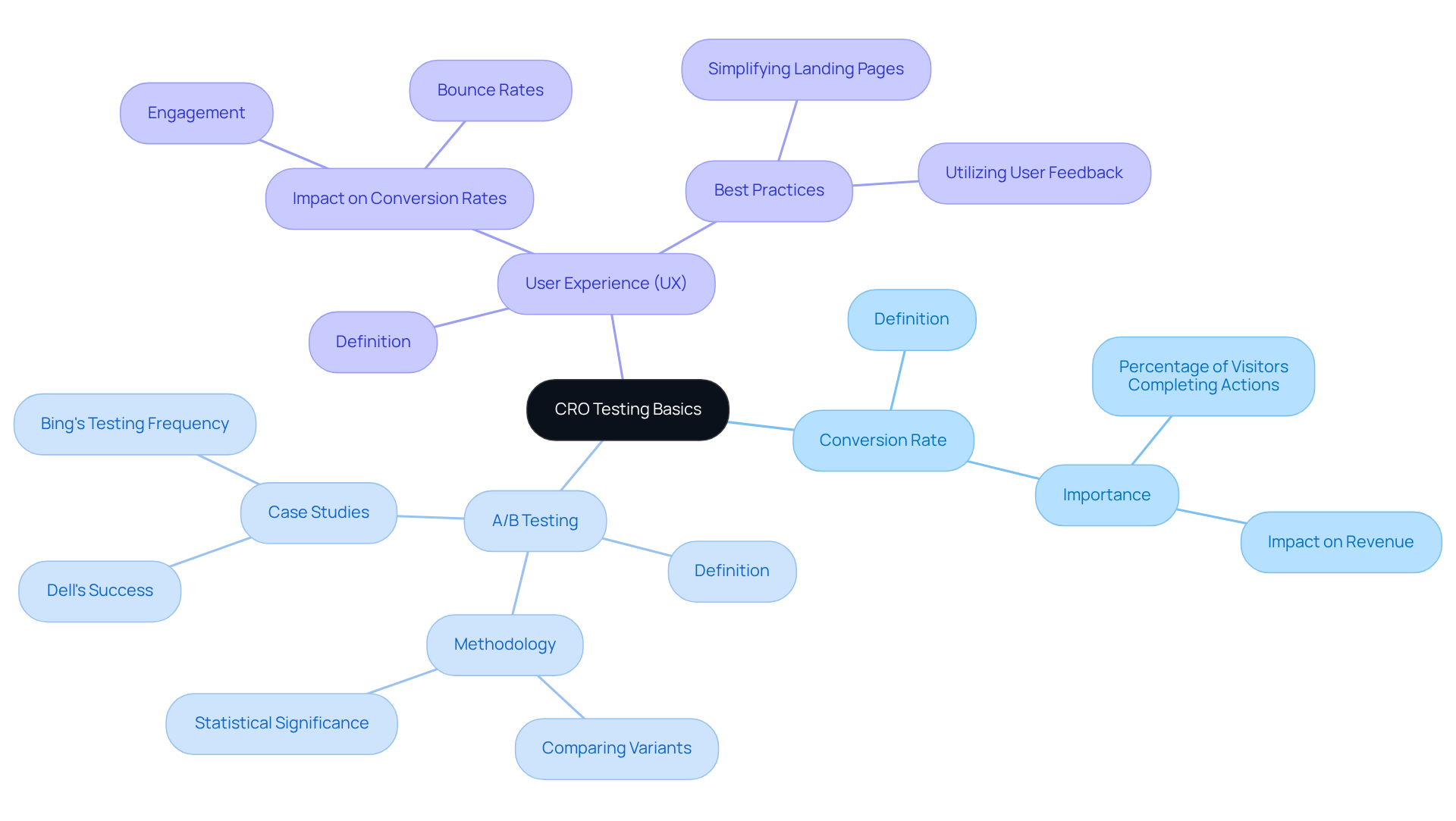
Conduct Preliminary Research and Data Collection
To effectively perform CRO testing, it is imperative to commence with thorough research and data collection. Here’s how to establish a robust foundation:
- Examine Current Metrics: Leverage tools such as Google Analytics to evaluate your transformation rates, bounce rates, and audience demographics. Understanding these metrics is essential, providing a baseline for your optimization efforts.
- Collect Feedback: Implement surveys or conduct interviews to uncover participant pain points and preferences. Gathering feedback from individuals is vital, as it reveals insights that numerical data alone may not offer, aiding in the identification of obstacles to conversion.
- Review Competitor Performance: Analyze competitors’ websites to identify successful strategies and areas for differentiation. This analysis can illuminate industry standards and innovative approaches that you can adapt for your brand.
- Utilize Heatmaps: Employ tools like Hotjar or Crazy Egg to . Heatmaps disclose where users click, scroll, and spend time, providing valuable insights into user behavior and engagement patterns.
This foundational data will inform your hypothesis formulation and CRO testing strategy, ensuring that your efforts are both targeted and effective.
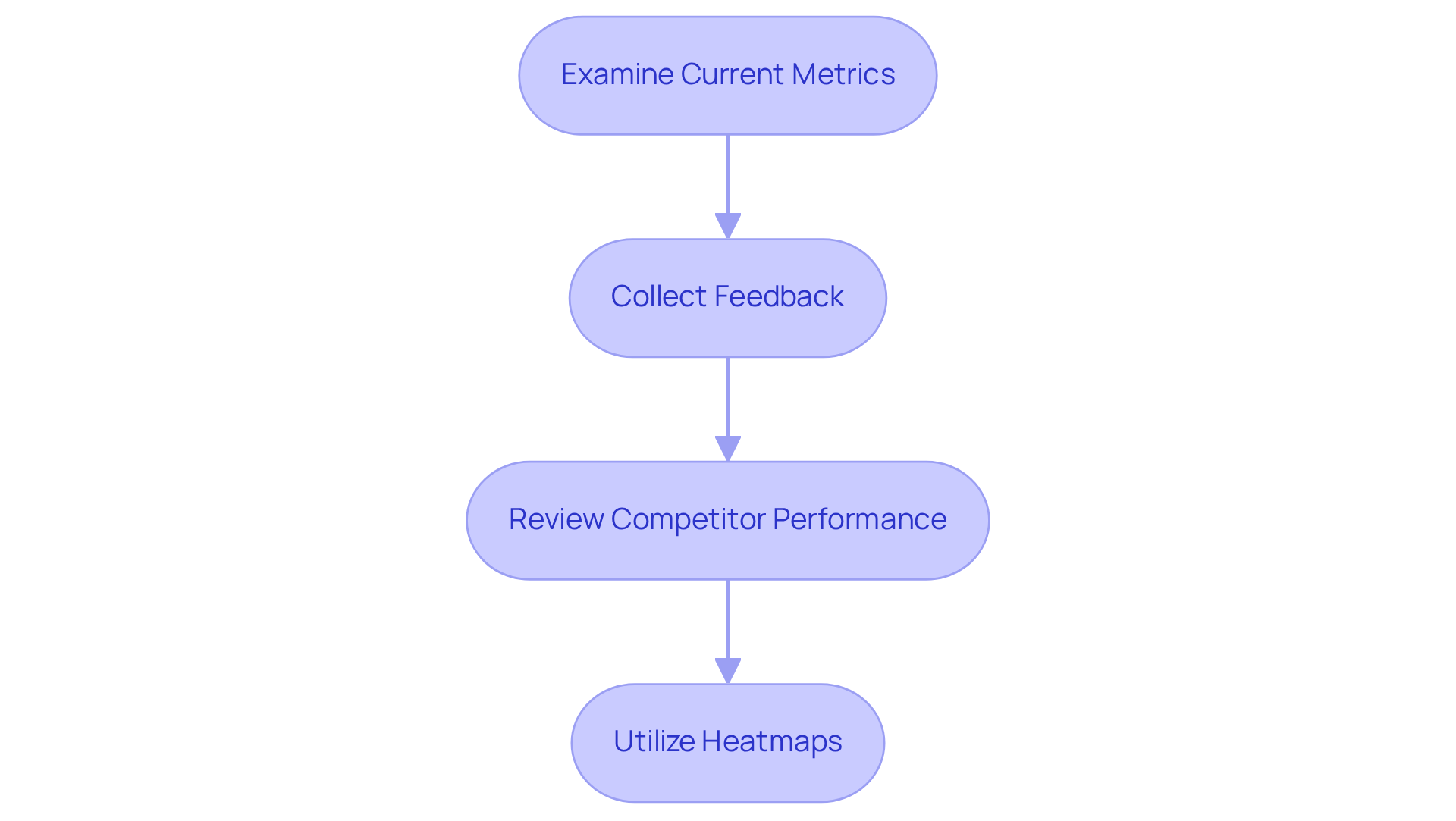
Formulate Hypotheses for Testing
Once sufficient data has been gathered, the next crucial step is to formulate hypotheses for your CRO testing. Here’s how to approach this effectively:
- Identify Key Areas for Improvement: Analyze your research to pinpoint specific elements of your site that may be hindering results, such as the checkout process or call-to-action buttons. Understanding can reveal where visitors drop off, guiding your focus. Monitoring micro achievements is crucial as it aids in recognizing friction points in the sales funnel before significant declines occur.
- Create Hypothesis Statements: Formulate clear and testable statements that link observations to proposed changes. For example, you could state, "If I alter the color of the 'Buy Now' button from blue to green, then the success rate will rise by 10%." This clarity facilitates effective outcome measurement. A structured CRO process, such as the SHIP optimization process, can guide you in developing these hypotheses.
- Prioritize Hypotheses: Rank your hypotheses based on their potential impact and ease of implementation. Focus on those that promise the highest returns with the least effort. For instance, high-impact changes such as streamlining the checkout process can yield notable enhancements in sales rates. It's important to note that only 22% of businesses express satisfaction with their conversion rates, underscoring the need for continuous improvement in CRO testing processes.
By establishing clear and actionable hypotheses, you lay the groundwork for effective evaluation and analysis, ultimately driving better results for your DTC brand.
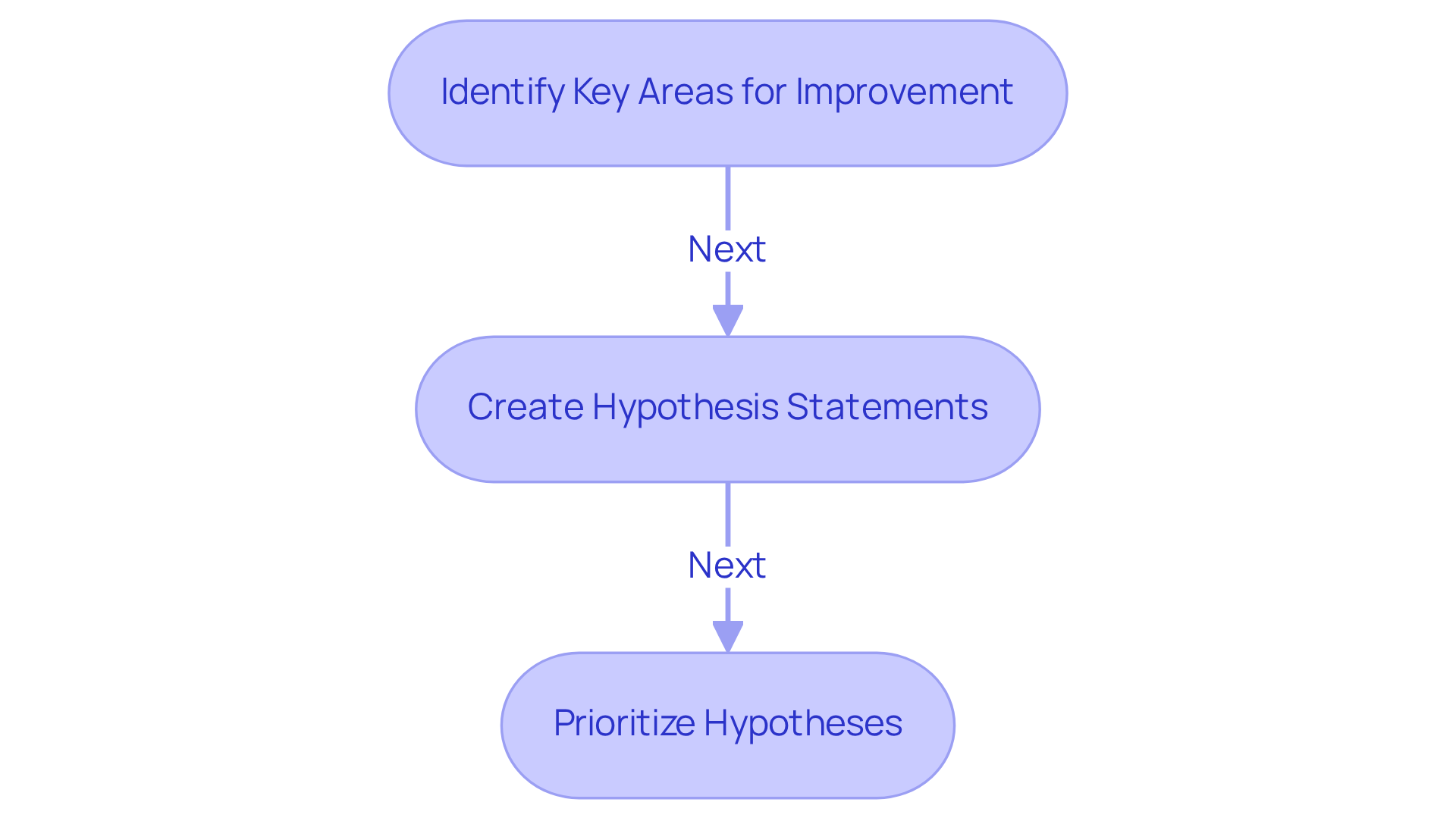
Execute CRO Tests Methodically
With your hypotheses firmly established, it's time to conduct your . Follow these essential steps to ensure a successful evaluation process:
- Choose the Right Evaluation Tool: Select a dependable A/B analysis tool, such as Optimizely or VWO, that aligns perfectly with your specific needs. These tools are crafted to facilitate effective cro testing and yield valuable insights.
- Set Up Your Test: Create variations of your webpage based on your hypotheses. Ensure that only one element is altered at a time to accurately isolate its effect on user behavior.
- Define Success Metrics: Clearly outline what success looks like for each evaluation, whether it’s an increased conversion rate, reduced bounce rate, or enhanced engagement. This clarity will guide your analysis.
- Conduct the Experiment: Initiate your evaluation and ensure it runs for a sufficient duration to collect statistically significant data. Research indicates that evaluations should generally operate for a minimum of one to two weeks to account for fluctuations in traffic and user behavior.
- Monitor Performance: Keep a vigilant eye on the assessment as it progresses to ensure everything functions correctly. Regular monitoring allows for swift adjustments should any issues arise.
By systematically carrying out cro testing, you will gather reliable information for analysis, ultimately leading to informed decisions that enhance your brand's profitability.
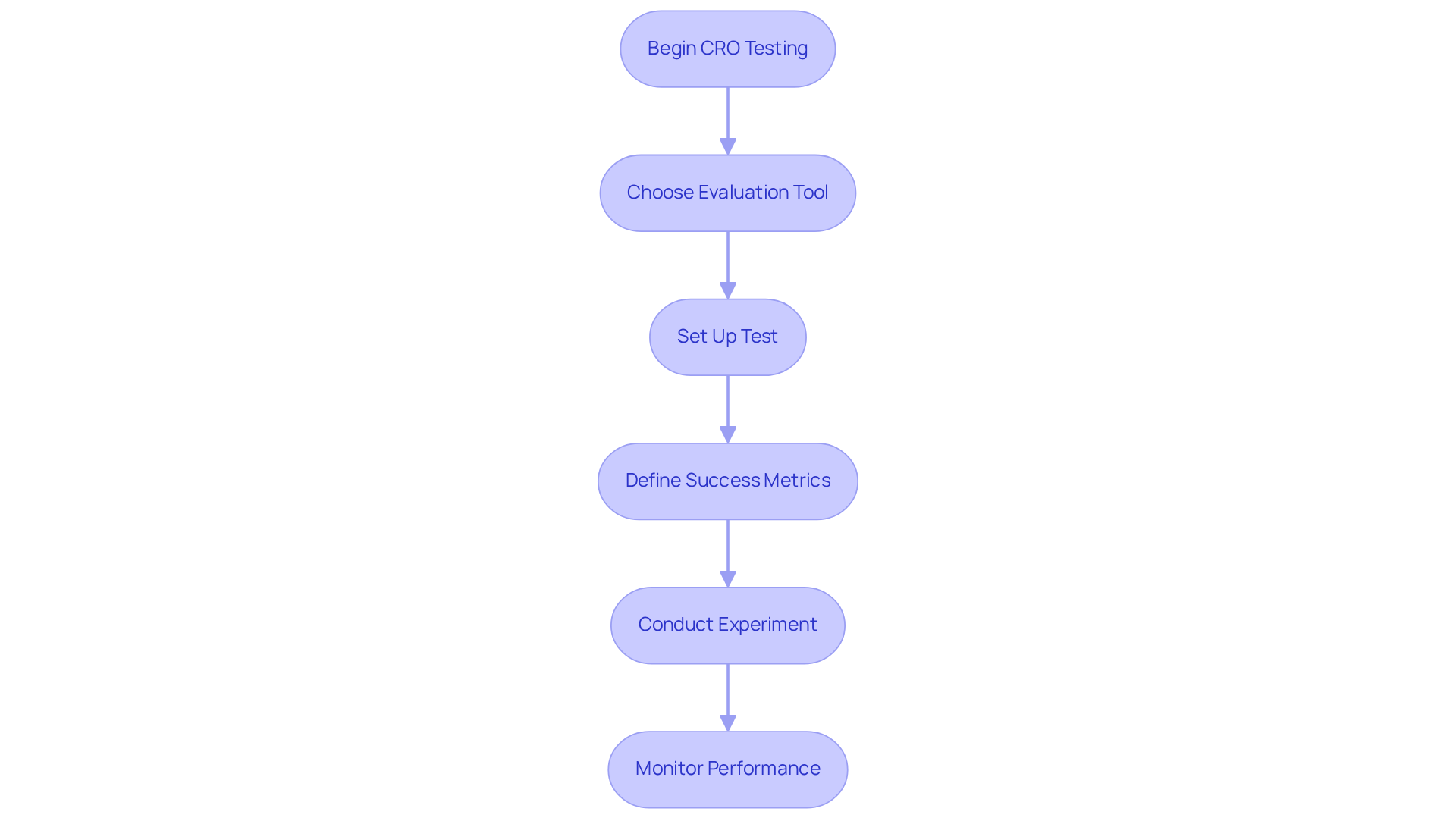
Analyze Test Results and Draw Insights
Examining your test outcomes is essential for fostering ongoing enhancement in your efforts for CRO testing. To ensure you extract maximum value from your tests, follow this structured approach:
- Collect Data: Begin by gathering comprehensive data from your testing tool. This should encompass exchange rates, user engagement metrics, and relevant statistical significance indicators.
- Compare Variants: Evaluate the performance of each variant against your predefined success metrics. Identify which version outperformed the others and analyze the reasons behind its success.
- Draw Insights: Look for trends and patterns within the data that can guide future tests. For instance, if a specific color scheme resulted in higher conversions, consider applying similar design elements in other areas of your site.
- Document Findings: Maintain a detailed record of your results and insights. This documentation is crucial for refining your testing strategy and ensuring that valuable lessons are not lost over time. Research indicates that only 39.6% of companies have a documented CRO testing strategy, which is vital for tracking progress and learning from past outcomes.
- Iterate and Optimize: Utilize the to guide your next series of evaluations. CRO testing is not a one-time effort; it requires ongoing iterations to achieve sustained success. Companies that utilize CRO tools typically see an average return on investment of 223%, underscoring the importance of systematic optimization.
By effectively analyzing test results, you can make informed decisions that enhance your DTC brand's profitability and drive further optimization.
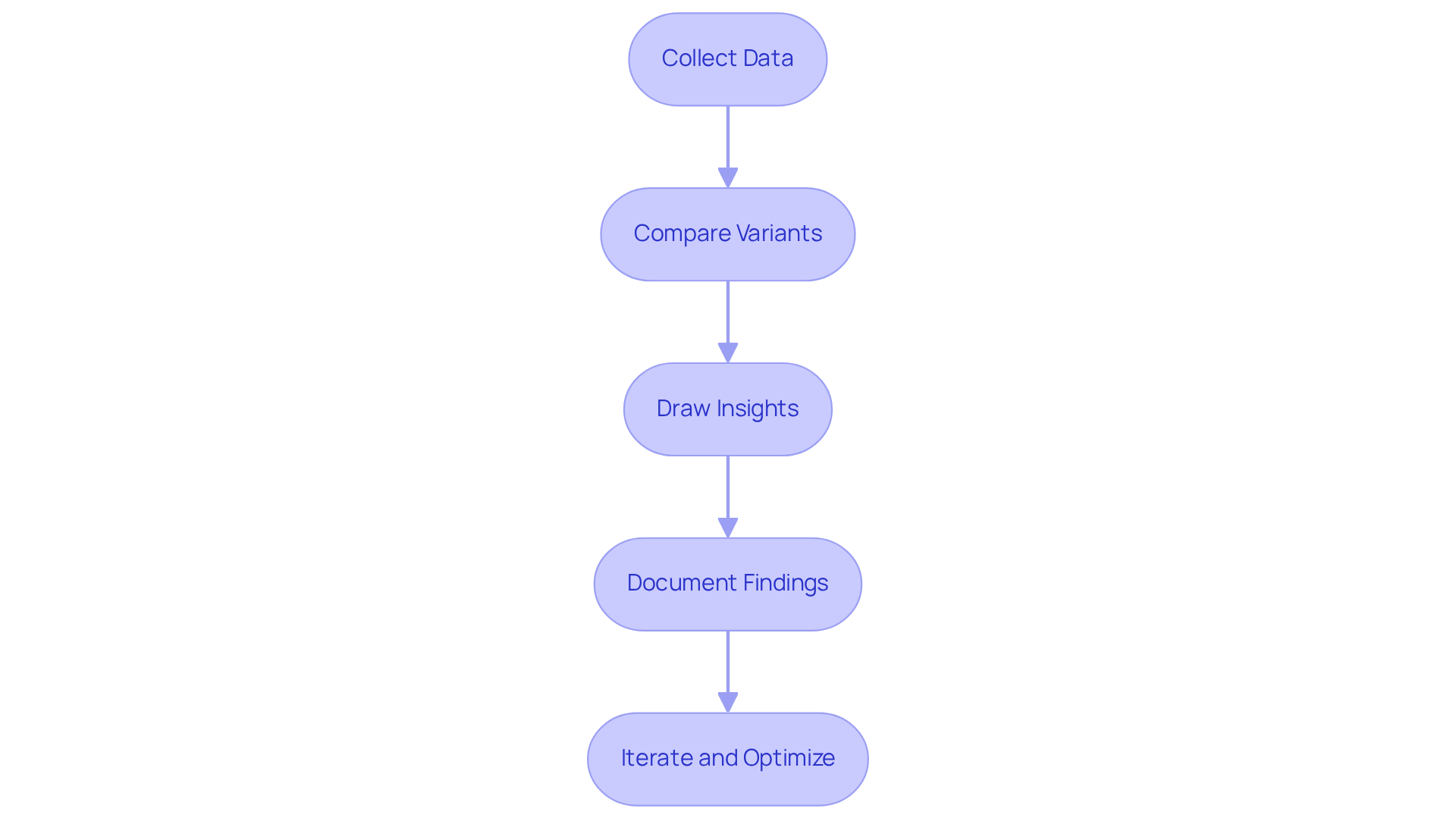
Conclusion
Mastering conversion rate optimization (CRO) testing is not merely beneficial; it is essential for direct-to-consumer (DTC) brands striving to enhance profitability. By systematically implementing the five key steps—understanding the basics, conducting thorough research, formulating hypotheses, executing tests methodically, and analyzing results—brands can significantly elevate their conversion rates and overall performance. The strategic application of CRO not only leads to increased sales but also fosters a deeper understanding of customer behavior and preferences.
Critical insights shared throughout the article underscore the importance of A/B testing and user experience in driving conversions. Gathering comprehensive data, formulating clear hypotheses, and utilizing reliable testing tools are emphasized as foundational elements for successful CRO initiatives. Moreover, the ongoing nature of CRO testing is highlighted, demonstrating that continuous iteration and optimization are vital for sustaining growth and competitiveness in the market.
Ultimately, embracing a structured approach to CRO testing can transform how DTC brands engage with their customers and optimize their online presence. As the landscape of e-commerce evolves, the ability to adapt and refine strategies based on data-driven insights will be paramount. By prioritizing CRO testing, brands not only boost their profitability but also enhance their customer experience, setting the stage for long-term success in a competitive marketplace.
Frequently Asked Questions
What is CRO testing?
CRO testing, or Conversion Rate Optimization testing, is a systematic approach aimed at enhancing the effectiveness of websites or landing pages in converting visitors into customers. It includes various methodologies such as A/B analysis, multivariate analysis, and experience evaluation.
What are the key concepts involved in CRO testing?
Key concepts in CRO testing include Conversion Rate, which is the percentage of visitors completing a desired action; A/B Testing, which compares two versions of a webpage to determine which performs better; and User Experience (UX), which refers to the overall experience a user has when interacting with a site.
How does A/B Testing work?
A/B Testing involves comparing two versions of a webpage to see which one performs better. This method is particularly effective in e-commerce, where even small changes can lead to significant increases in sales. For example, Dell experienced a 300% increase in success rates due to their A/B trials.
Why is User Experience (UX) important for conversion rates?
A well-optimized User Experience can significantly enhance engagement and reduce bounce rates, which in turn can lead to higher conversion rates.
What are some optimal approaches for conducting A/B experiments?
Optimal approaches include prioritizing evaluations based on potential impact, maintaining a repository of previous experiments for ongoing learning, and ensuring clear communication about expectations.
What preliminary research is needed before performing CRO testing?
Preliminary research should include examining current metrics using tools like Google Analytics, collecting feedback through surveys or interviews, reviewing competitor performance, and utilizing heatmaps to visualize user interactions on your site.
How can current metrics inform CRO testing?
Analyzing current metrics such as transformation rates, bounce rates, and audience demographics provides a baseline for optimization efforts and helps identify areas for improvement.
What role does feedback play in CRO testing?
Feedback from participants through surveys or interviews reveals insights into their pain points and preferences, helping to identify obstacles to conversion that numerical data alone may not uncover.
How can competitor performance analysis benefit CRO testing?
Reviewing competitors’ websites can highlight successful strategies and innovative approaches, allowing you to adapt and differentiate your brand in the industry.
What tools can be used to visualize user interactions on a website?
Tools like Hotjar or Crazy Egg can be employed to create heatmaps that show where users click, scroll, and spend time, providing valuable insights into user behavior and engagement patterns.
FAQs











